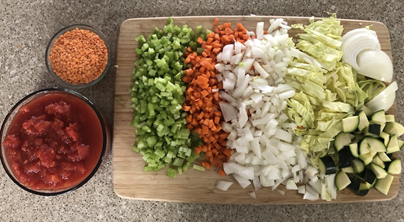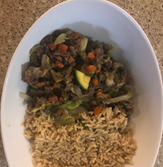Here's what happened when all I ate were recipes from Canada's Food Guide
By Jordyn Grantham | June 13, 2022
 I live in Saskatoon, and for three days, all I ate were recipes from the Canada's Food Guide. Here's what happened!
I live in Saskatoon, and for three days, all I ate were recipes from the Canada's Food Guide. Here's what happened!
Let me start by saying, I love food, cooking, and grocery shopping, but a few months ago, I found myself in a bit of a food rut and lacking inspiration in the kitchen. Food ruts happen to everyone, even nutrition students!
I was surprised that it wasn't Pinterest or Instagram that got me out of this rut. It was the Canada's Food Guide. I am currently the University of Saskatchewan Student Ambassador for the Canada's Food Guide, and it is my responsibility to promote Canada's Food Guide on my campus. Some of this role involves promoting the Guide on social media, and in December, I started to film videos of recipes from the Canada's Food Guide. I've always used the principles of the healthy eating plate to build healthy meals, but before this, I rarely cooked with the recipes in the Canada's Food Guide. After creating the recipes, I was impressed they were nutritious, creative, and simple. As a lover of Italian food, how had I never heard of passata? As my program transitioned back to in-person learning and I traded couches for the classroom and cooking for commuting, would these recipes work for the busy life of a university student? I loved remote learning; being able to brew coffee and enjoy scrambled eggs instead of commuting or roasting vegetables while attending an online lecture meant I enjoyed fresh meals more often. The transition back was tricky. I've eaten more take-out, spent more money on convenience options, and cooked less. I knew I needed another refresh.
Many people don't know that Canada's Food Guide is a comprehensive website, not just a picture of a plate of food. Some articles explain how to eat well, meal plan, grocery shop on a budget, and adjust recipes to meet your needs! There is also information about sustainable eating, food safety, and 109 recipes! Armed with all Canada's Food Guide information, I decided to get back into meal planning and prepping. I challenged myself to eat only Canada's Food Guide recipes for three days.
I decided to utilize the Guide’s
meal planning and
budgeting resources and then carefully selected recipes. It was important to me that the recipes met certain criteria:
- I wanted recipes that suited my budget. Moving to in-person learning meant working less and paying more rent.
- I wanted ingredients that would work in multiple recipes. Buying too many different ingredients normally means I waste the food!
- I need recipes that would store, pack and reheat well.
Here's how I planned what I wanted to make:
- I scanned my grocery store flyer and noticed that ground turkey was on sale. This sale helped me choose my first lunch/dinner meal.
- I chose two lunch/dinner meals and decided to eat three servings of each.
- I chose one lunch/dinner meal with meat and one with a plant-based protein.
- I chose lunch/dinner meals that used the same vegetables.
- I chose two snacks and one breakfast; I eat the same breakfast all week.
- I chose recipes that typically have less expensive produce. Additionally, there is less seasonal produce available in Saskatchewan in March, so I looked at recipes that had apples, bananas, frozen fruit, cabbages, carrots, celery, and onion.
I made
Apple Pie Oatmeal,
Lentil Bolognese,
Turkey Stir Fry,
Crispy Chickpeas, and
Open-faced Apple Sandwiches!




I also hard-boiled some eggs and bought extra bananas to eat at breakfast.
The cost of groceries is at the forefront of every student's mind, especially lately. Now grocery prices vary throughout the city, province, and country, so the cost of the recipes that I made is likely to vary a great deal. But for a University of Saskatchewan student living on the city's east side, it cost me about $42.45 to make six recipes from the Canada's Food Guide, and I froze the extra servings I didn't eat. In total, it cost me about $27.36 to eat for three days or about $9.12 per day. This amount was less than I anticipated. If I ate this way for the remainder of the month, it would cost about $273.60 for the month. Utilizing the advice from the Guide about careful meal selection and planning, shopping according to grocery sales, and incorporating plant-based proteins were essential to bringing this grocery bill down.
The recipes were delicious, simple to prepare, and utilized less-expensive ingredients. It took me about an hour to sort through grocery store flyers and plan my meals, but I spent less time throughout the week cooking and preparing food. I also only made one trip to the grocery store compared to my usual two or three. This challenge also helped me save money because I didn't order take-out or buy food while on campus. Using the Canada's Food Guide to plan my meals for the week helped me to eat well during a very busy time in my semester and save money. I will continue to look to Canada's Food Guide in the future for recipe inspiration that suits my budget, lifestyle, and taste.
Read Jordyn's Post - (Part 1) Campus Quarantine: How I’m Coping with COVID-19 as a Student
Read Jordyn's Post - (Part 2) Campus Quarantine: How I’m Coping with COVID-19 as a Student

Jordyn is a Nutrition student at the University of Saskatchewan. A former ultrasound technologist who’s passion for cooking led her to back to school as a mature student to become a registered dietitian! She is passionate about all things food, cooking, and gardening and is most interested in public health nutrition, food security, and health promotion.
Back to Practice Blog